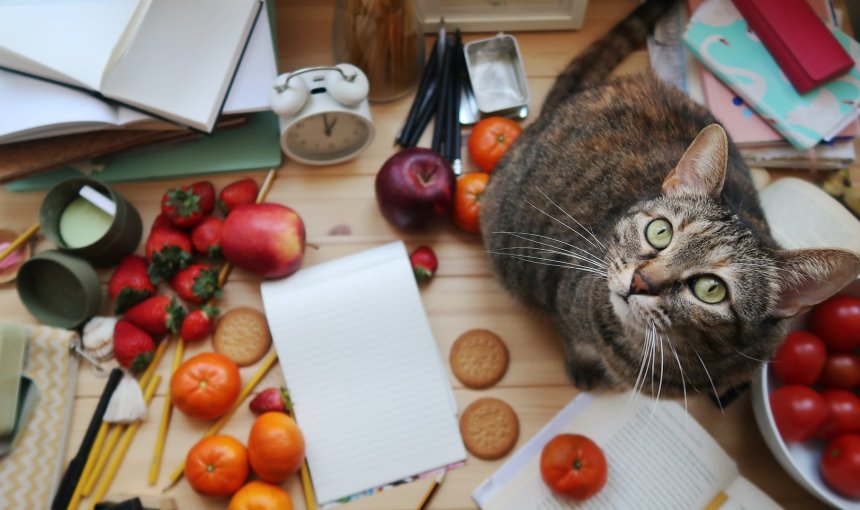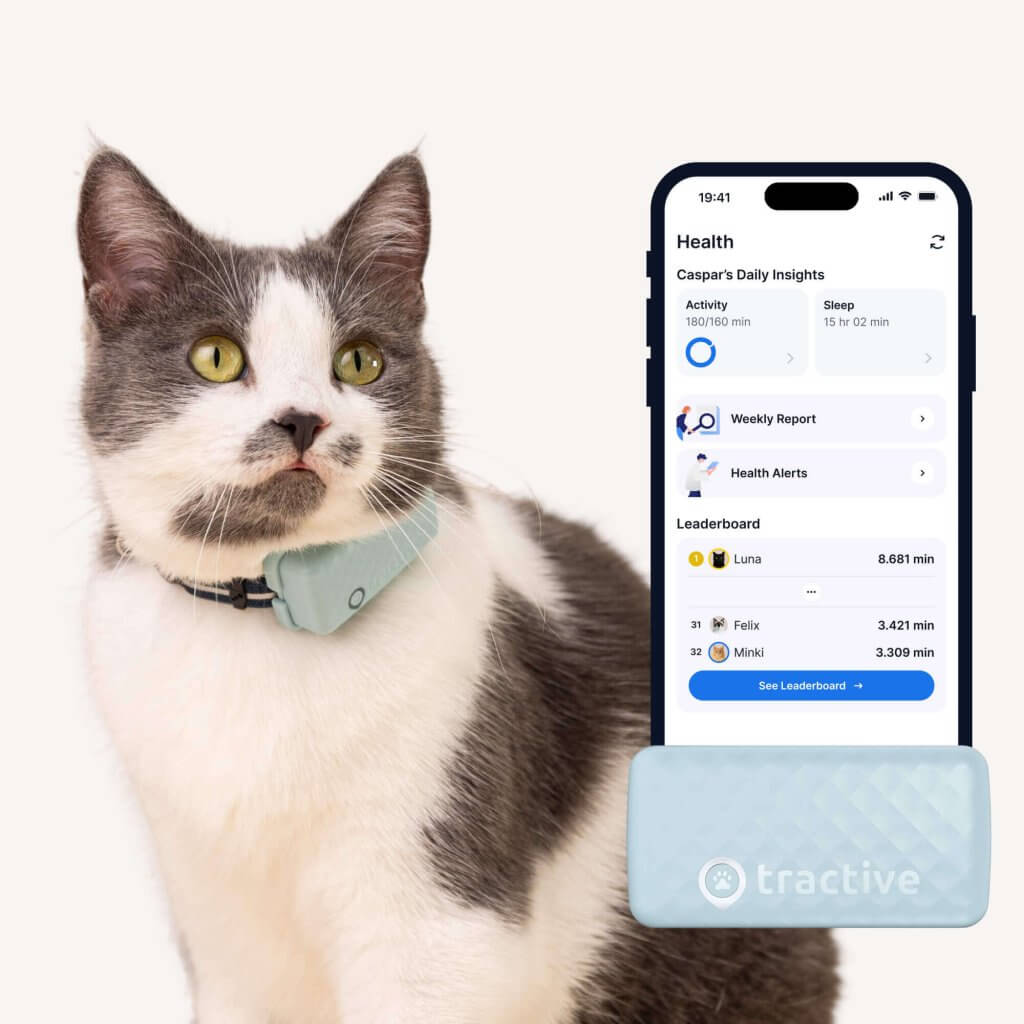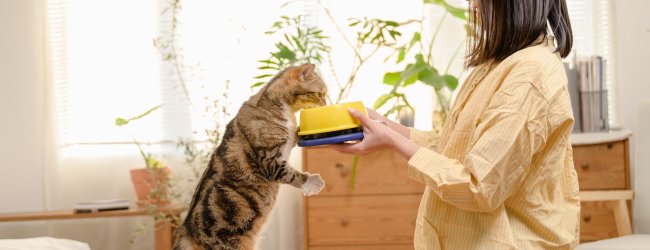What Human Foods Can Cats Eat?
Cats can safely eat a bunch of human foods - but there's a reason why vets recommend these as only 10% of their diet. Here are a couple of safe options for your feline friend - and why you should always serve them human foods in moderation.

Left to their own devices, cats are notoriously picky eaters. So if you’ve found yourself in a stand-off with your feline friend during mealtimes, you’re not alone. Cat parents around the world are wandering the aisles of their local grocery stores, wondering: what human foods can cats eat? And just how much? So here’s a comprehensive guide to what human foods cats can eat – and why it’s always a good idea to serve them in moderation.

Find out where your cat spends their time.
Read moreWhat can cats eat?
Cats are obligate carnivores. They primarily eat meat from animal sources, which include essential amino acids like taurine. It’s why you’ll find commercial cat food that’s primarily formulated to meet these nutritional needs. (Also making it a good choice for their main diet.)
⚠️ Avoid feeding your cat raw foods of any kind (especially meat, fish, and eggs.) These might contain harmful bacteria that may upset their stomach. Make sure to check out our comprehensive list of what cats can’t eat.
In general, human foods should only be around 10% of their overall diet. Vets recommend feeding your cat a mix of wet or canned food – as well as dry foods. Just make sure not to overdo it with the dry foods, since they might dehydrate your cat over time. Meat-based wet foods like KatKin or Scrumbles are good options. Also remember: canned foods also might be high in salt, sodium, and oils. So make sure you serve these to your cat in moderation.
What human foods can cats eat?
Can cats eat cheese?
In general, yes. Cats can eat cheese – but ideally, you should serve them small amounts.1 Why? Because most adult cats are lactose intolerant. So while your cat might love the taste of cheese, it doesn’t do much for them nutritionally. And watch out if you find them nibbling around a full block – it might lead to digestive problems in large amounts, including diarrhea. Cheese might be lower on the lactose side, but it’s better to be safe than sorry.
Can cats eat yogurt?
Yes, in small amounts. Sounds counterintuitive, right? But turns out, Greek-style yogurts are actually pretty low in lactose because of how they’re produced. So if your cat is sniffing around your dairy products, there’s no harm in giving them a lick of plain, unflavored, whole-milk yogurt.
Can cats eat peanut butter?
Yes, but make sure it’s a (very) small amount. Much like cheese, peanut butter isn’t inherently toxic to cats. But it’s far from an ideal treat either. Most nut butters tend to be high in fat, which can lead to digestive problems or excessive weight gain over time. But if your cat is crying up a storm demanding a taste, make sure it’s a tiny lick, max.
Besides, you should also ensure it’s a plain peanut butter without xylitol. Much like chocolate, xylitol (a sugar substitute) is highly toxic to cats and can even be fatal in large doses.2 It’s why we recommend keeping your pets away from your Halloween or Christmas candy.
Can cats eat popcorn?
Yes and no. On one hand, plain, air-popped popcorn itself is pretty safe for your cat to eat in small amounts. But on the other hand, popcorn kernels are small enough for your cat to choke on if they’re not careful.3
Besides, other types of store-bought popcorn might include artificial flavoring or additives that might be harmful to your cat. So we’d recommend keeping popcorn as a small, occasional treat.
Can cats eat carrots?
Yes and no. Much like popcorn, carrots are non-toxic for cats. But also like popcorn, raw carrots in small slices might create a choking hazard.4 So if you’d like to add a few veggies to your cat’s meals, go for cooked carrots instead. (Which are softer and easier to swallow.)
Don’t forget: your cat is an obligate carnivore. So while carrots are safe for them to eat, they don’t really add much value by way of nutrition.

Get health alerts for your cat
Our cats can’t always tell us if something’s wrong. But if their tracker detects unusual changes in their routine, you’ll get an alert, helping you catch potential issues early.
Can cats corn?
Yes, and your cat is likely already eating it if you’ve been serving them commercially-made cat food. Corn is a staple filler for many such brands, including many vet-approved cat food labels.5
But watch out: you’re better off serving your cat corn in small amounts. Much like carrots, corn doesn’t have such a positive impact on your cat’s health. And if you’re serving it to them with butter, oil, fat, salt, or other seasonings, you might give them a bad case of tummy upset.
Vets also recommend keeping corn away from your cat’s plate if they’re overweight. (They tend to be pretty high in calories – way more than what your cat might need in a day.) Here’s how you can figure out your cat’s body condition score.
Can cats eat potatoes?
Yes, boiled or cooked plain potatoes are safe for cats to eat. But again, much like carrots or corn, they likely do more to improve your health over your cat’s. In general, it’s fine to give them a lick or bite of potatoes off your kid’s plate – but only in moderation.
On the other hand, raw potatoes contain solanine, a chemical that’s harmful to cats.6 So make sure to cook your potatoes to get rid of it. Also, avoid serving your cat potatoes that have been buttered, salted, or seasoned. Your cat’s digestive system isn’t built to handle them.
Can cats eat lettuce?
Yes, and it might even be beneficial for them. Lettuce is a hydrating vegetable that’s both low in calories and high in micronutrients. So it can be a great option for cats who aren’t drinking enough water.
Can cats eat shrimp?
Yes, but only cooked and in moderation. Shrimp is a great source of protein for your cat. And by cooking it, you also help get rid of any harmful bacteria that might give your cat any digestive problems.7
In general, both wild and farmed shrimp are safe for cats to eat. But try and make it an occasional treat. Farmed shrimp might contain traces of antibiotics and wild shrimp traces of mercury. Both of which can be harmful to your cat in high amounts and with repeated exposure.
Besides, make sure to remove any parts of the shrimp that might dislodge into your cat’s throat instead. (Like the head, tail, and shell.)
Can cats eat sardines?
Yes, and they’re excellent for your cat’s health overall.8 Sardines contain healthy omega-3 oils which are great for your cat’s eyes and heart. In fact, if you’ve got a senior cat at home, they’ll benefit from a diet high in oily fish and healthy fats. (Because it can help them with mobility-reducing conditions like arthritis.)
Can cats eat tuna?
Yes, but only in small amounts. If you’re feeding them canned tuna that’s prepared for humans instead, watch out. You might be feeding them more unsaturated fats than their systems can handle. Which, in the long run, might make your cat gain weight and harm their overall health.
Can cats eat bread?
Yes, in general cats can eat small amounts of bread on occasion. But much like potatoes, it doesn’t offer them much nutritional value. So it’s best not to replace your cat’s regular diet with bread instead.
Now that we’ve covered what human foods cats can eat – how about the “food” your cat might find in your garden or lawn?
What plants can cats eat?
Ever found your cat nibbling on your houseplants or on the grass in your backyard? Yes, it’s true – cats can and do eat grass on rare occasions. (Usually to help them digest their meat-based meals better.) Here’s a deep dive into why cats eat grass and what steps you can take to build a cat-friendly garden.
Can cats eat grass?
Yes, in most cases, grass is actually safe for cats to eat. Just make sure it’s not been sprayed with pesticides or any other harmful chemicals. You could invest in cat grass as well – aka, certain species of grass (like oats, barley, and millet) that are safe for cats to eat.
Can cats eat catnip?
Yes, catnip is actually safe for cats to eat – not just sniff! It’s a species of fern which is part of the mint family. Catnip contains a compound called nepetalactone, which can give your cat an energy boost – making them temporarily hyperactive, rolling around or rubbing against you. Or, on the other hand, sniffing or licking catnip might even make your cat relax a bit. (Plus, it’s perfectly safe and non-toxic.)
Catnip’s (rather entertaining) effects don’t usually last longer than 10-15 minutes. In fact, it’s one of the many easy indoor plants that are safe for cats and dogs alike. Just make sure your cat isn’t over-exposed to it, since it might overstimulate them.
What fruits can cats eat?
Despite being obligate carnivores, cats can safely eat a number of fruits. But in most cases, you’re better off serving these in a puree or without seeds. Here are a couple:
- Apples, pears, pumpkins, and watermelons. Make sure to remove the seeds of these fruits as they contain cyanide, which can be toxic to your cat.
- Bananas, cranberries, and pineapples. But make sure to serve these fruits in moderation. They tend to be high in sugar, which can upset your cat’s tummy.
- Blueberries, strawberries, and raspberries. All these fruits are high in micronutrients that are healthy for your cat. Just go easy on the raspberries, as they contain trace amounts of xylitol. (Which won’t harm your cat – but always better to be on the safe side.)
What vegetables can cats eat?
Cats’ systems might be built primarily for meat. But some vegetables can help them get important micronutrients in their diet too. Here are some that are safe for them to eat:
- Cucumbers, lettuce, and celery can help keep your cat hydrated and healthy. (Which can help prevent UTIs.)
- Green beans can help your cat get some iron, protein, and fiber all in one. Ideally, fresh green beans are a healthier option. But if you’ve found a canned brand, try and go for one that’s low in sodium.
And there you have it – a whole bunch of human foods that cats can eat. Again, remember that the best choice for your cat is a vet-approved cat food brand. Since they’re obligate carnivores, cats are built to eat meat from animal sources first. If you do feed them any of these foods, make sure it’s plain, unsalted, and doesn’t include any artificial colors or flavors. Happy feeding!



